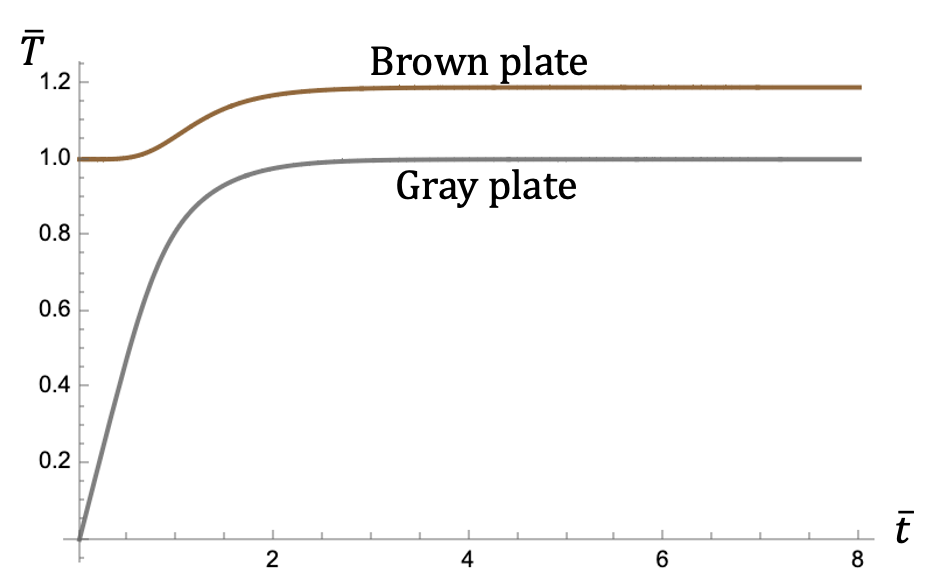To answer this question we must of course utilize the laws of thermodynamics. It also deals with radiation and so the plane-parallel nature of the problem makes the math more tractable.
First Law:
$dU = Q + W = m*Cp*dT$ (etc.)
There is no work involved, and so we can simplify to:
$dU = Q = m*Cp*dT$
Thus, the first law states that to increase a body's temperature (+dT), one requires heat (Q), and this is an increase in a body's internal energy (+dU).
It is important to note that the the First Law and dU corresponds to a specific body, and this is consistent with the equation for heat, Q, for this plane-parallel scenario as a general equation:
$Q_{hot->cool} = σ(T_{hot}^4 - T_{cool}^4)$
Q is the heat which the specific body receives, and so the specific body is usually the 2nd term in the above equation. Then, in relation to the first term in the heat equation, if the result for Q is positive, then it means that the specific body of the 2nd term is receiving heat; otherwise if Q is negative then it means the 2nd body term is not being heated, which is to say, it is not having its temperature raised, by the body of the first term, which implies that it must be the 2nd term which in fact has higher temperature. We should keep in mind that heat is a transient action, much like work is a transient action, and they are both in general something which one body performs upon another.
Initially, the heat equation for the bottom surface would look like:
$Q_{Sun->bottom} = F_{Sun} - σT_{bottom}^4$
Thermal equilibrium for a given body is established when that body has no change in internal energy (dU = 0), which means that its temperature doesn't change via the First Law (dT = 0). Thus, if we are seeking when dU = dT = 0, then via the First Law for this scenario also requires Q = 0.
$dU = Q_{Sun->bottom} = F_{Sun} - σT_{bottom}^4 = 0$
And then the bottom surface emits the same energy as the input
$F_{Sun} = 240W/m^2 = σT_{bottom}^4$
so that
$T_{bottom} = 255K$ (approx)
The question is: what happens with this second plate involved?
The first thing about that is that the Sun does not interact with it, and so there's no heat from the Sun for it.
Second, there is definitely heat from the bottom surface to the second (grey) plate, and in general the equation is going to be:
$Q_{bottom->grey} = σ(T_{bottom}^4 - T_{grey}^4)$
Since heat first acts on the bottom plate, or, if we considered that the grey plate is inserted after the bottom plate came to equilibrium, either way, the bottom plate always has a higher initial temperature than the grey plate. Therefore, Q is always from the bottom plate acting on the grey plate.
With thermal equilibrium defined as Q = 0, then the above equation results in thermal equilibrium where
$T_{bottom} = T_{grey}$
which is 255K.
Of course, some solutions suggest that the radiation from the grey plate must add with the radiation from the Sun and act as additional heating forcing on the bottom plate. Again, it is extremely important to understand that the First Law applies to a given body, not a system of bodies, and likewise, the heat equations apply to pairs of bodies, not systems of bodies. If it needs further explanation to understand, consider temperature, and that fact that temperature is part of the first law, as we saw in the first equation. The point here being that temperature is an intrinsic, in-situ property of A BODY, i.e., an object, not a system of spatially-separated objects; in fact one could even say, given that heat is a transient phenomenon which acts at the surface of a body, that for all intents and purposes, temperature is measured at the surface of a body, and this makes sense whether you measure temperature at the surface via radiative means, or, with a thermometer stuck inside a body (there is a new surface created between the thermometer and the body being measured - the interface between the body and the thermometer).
And so, sure, if you proceed with summing all energies, thinking that the solar energy can be summed with the energy from the grey plate, then indeed you would think that the bottom plate should go higher in temperature.
However, the First Law is about directing us to the correct way to solve this problem, and it is really does not tell us to sum all energy, but instead, to consider a body by itself and then the heat exchange it has with each other body it forms pairs with independently, not in sum. The reason you have to do this is because of view factors.



